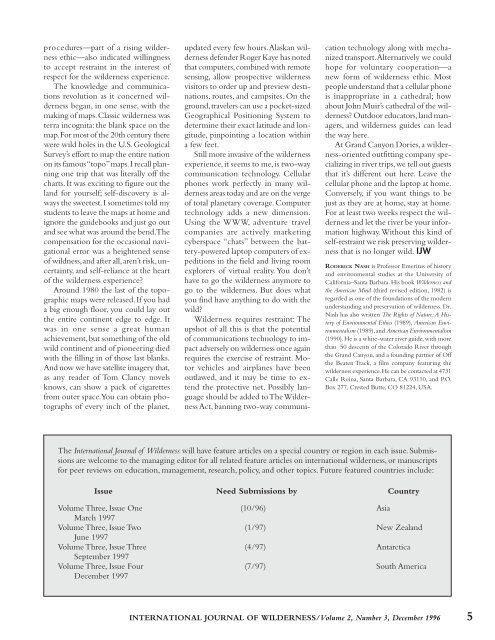P3-Vol 2.No3 Dec 96 - International Journal of Wilderness
P3-Vol 2.No3 Dec 96 - International Journal of Wilderness
P3-Vol 2.No3 Dec 96 - International Journal of Wilderness
Create successful ePaper yourself
Turn your PDF publications into a flip-book with our unique Google optimized e-Paper software.
procedures—part <strong>of</strong> a rising wilderness<br />
ethic—also indicated willingness<br />
to accept restraint in the interest <strong>of</strong><br />
respect for the wilderness experience.<br />
The knowledge and communications<br />
revolution as it concerned wilderness<br />
began, in one sense, with the<br />
making <strong>of</strong> maps. Classic wilderness was<br />
terra incognita: the blank space on the<br />
map. For most <strong>of</strong> the 20th century there<br />
were wild holes in the U.S. Geological<br />
Survey’s effort to map the entire nation<br />
on its famous “topo” maps. I recall planning<br />
one trip that was literally <strong>of</strong>f the<br />
charts. It was exciting to figure out the<br />
land for yourself; self-discovery is always<br />
the sweetest. I sometimes told my<br />
students to leave the maps at home and<br />
ignore the guidebooks and just go out<br />
and see what was around the bend. The<br />
compensation for the occasional navigational<br />
error was a heightened sense<br />
<strong>of</strong> wildness, and after all, aren’t risk, uncertainty,<br />
and self-reliance at the heart<br />
<strong>of</strong> the wilderness experience?<br />
Around 1980 the last <strong>of</strong> the topographic<br />
maps were released. If you had<br />
a big enough floor, you could lay out<br />
the entire continent edge to edge. It<br />
was in one sense a great human<br />
achievement, but something <strong>of</strong> the old<br />
wild continent and <strong>of</strong> pioneering died<br />
with the filling in <strong>of</strong> those last blanks.<br />
And now we have satellite imagery that,<br />
as any reader <strong>of</strong> Tom Clancy novels<br />
knows, can show a pack <strong>of</strong> cigarettes<br />
from outer space. You can obtain photographs<br />
<strong>of</strong> every inch <strong>of</strong> the planet,<br />
updated every few hours. Alaskan wilderness<br />
defender Roger Kaye has noted<br />
that computers, combined with remote<br />
sensing, allow prospective wilderness<br />
visitors to order up and preview destinations,<br />
routes, and campsites. On the<br />
ground, travelers can use a pocket-sized<br />
Geographical Positioning System to<br />
determine their exact latitude and longitude,<br />
pinpointing a location within<br />
a few feet.<br />
Still more invasive <strong>of</strong> the wilderness<br />
experience, it seems to me, is two-way<br />
communication technology. Cellular<br />
phones work perfectly in many wilderness<br />
areas today and are on the verge<br />
<strong>of</strong> total planetary coverage. Computer<br />
technology adds a new dimension.<br />
Using the WWW, adventure travel<br />
companies are actively marketing<br />
cyberspace “chats” between the battery-powered<br />
laptop computers <strong>of</strong> expeditions<br />
in the field and living room<br />
explorers <strong>of</strong> virtual reality. You don’t<br />
have to go the wilderness anymore to<br />
go to the wilderness. But does what<br />
you find have anything to do with the<br />
wild?<br />
<strong>Wilderness</strong> requires restraint: The<br />
upshot <strong>of</strong> all this is that the potential<br />
<strong>of</strong> communications technology to impact<br />
adversely on wilderness once again<br />
requires the exercise <strong>of</strong> restraint. Motor<br />
vehicles and airplanes have been<br />
outlawed, and it may be time to extend<br />
the protective net. Possibly language<br />
should be added to The <strong>Wilderness</strong><br />
Act, banning two-way communi-<br />
cation technology along with mechanized<br />
transport. Alternatively we could<br />
hope for voluntary cooperation—a<br />
new form <strong>of</strong> wilderness ethic. Most<br />
people understand that a cellular phone<br />
is inappropriate in a cathedral; how<br />
about John Muir’s cathedral <strong>of</strong> the wilderness?<br />
Outdoor educators, land managers,<br />
and wilderness guides can lead<br />
the way here.<br />
At Grand Canyon Dories, a wilderness-oriented<br />
outfitting company specializing<br />
in river trips, we tell out guests<br />
that it’s different out here. Leave the<br />
cellular phone and the laptop at home.<br />
Conversely, if you want things to be<br />
just as they are at home, stay at home.<br />
For at least two weeks respect the wilderness<br />
and let the river be your information<br />
highway. Without this kind <strong>of</strong><br />
self-restraint we risk preserving wilderness<br />
that is no longer wild. IJW<br />
RODERICK NASH is Pr<strong>of</strong>essor Emeritus <strong>of</strong> history<br />
and environmental studies at the University <strong>of</strong><br />
California–Santa Barbara. His book <strong>Wilderness</strong> and<br />
the American Mind (third revised edition, 1982) is<br />
regarded as one <strong>of</strong> the foundations <strong>of</strong> the modern<br />
understanding and preservation <strong>of</strong> wilderness. Dr.<br />
Nash has also written The Rights <strong>of</strong> Nature: A History<br />
<strong>of</strong> Environmental Ethics (1989), American Environmentalism<br />
(1989), and American Environmentalism<br />
(1990). He is a white-water river guide, with more<br />
than 50 descents <strong>of</strong> the Colorado River through<br />
the Grand Canyon, and a founding partner <strong>of</strong> Off<br />
the Beaten Track, a film company featuring the<br />
wilderness experience. He can be contacted at 4731<br />
Calle Reina, Santa Barbara, CA 93110, and P.O.<br />
Box 277, Crested Butte, CO 81224, USA.<br />
The <strong>International</strong> <strong>Journal</strong> <strong>of</strong> <strong>Wilderness</strong> will have feature articles on a special country or region in each issue. Submissions<br />
are welcome to the managing editor for all related feature articles on international wilderness, or manuscripts<br />
for peer reviews on education, management, research, policy, and other topics. Future featured countries include:<br />
Issue Need Submissions by Country<br />
<strong>Vol</strong>ume Three, Issue One (10/<strong>96</strong>) Asia<br />
March 1997<br />
<strong>Vol</strong>ume Three, Issue Two (1/97) New Zealand<br />
June 1997<br />
<strong>Vol</strong>ume Three, Issue Three (4/97) Antarctica<br />
September 1997<br />
<strong>Vol</strong>ume Three, Issue Four (7/97) South America<br />
<strong>Dec</strong>ember 1997<br />
INTERNATIONAL JOURNAL OF WILDERNESS/<strong>Vol</strong>ume 2, Number 3, <strong>Dec</strong>ember 19<strong>96</strong> 5










